- Advice
- Camping Tips
- Camping Safety
Staying safe on the campsite
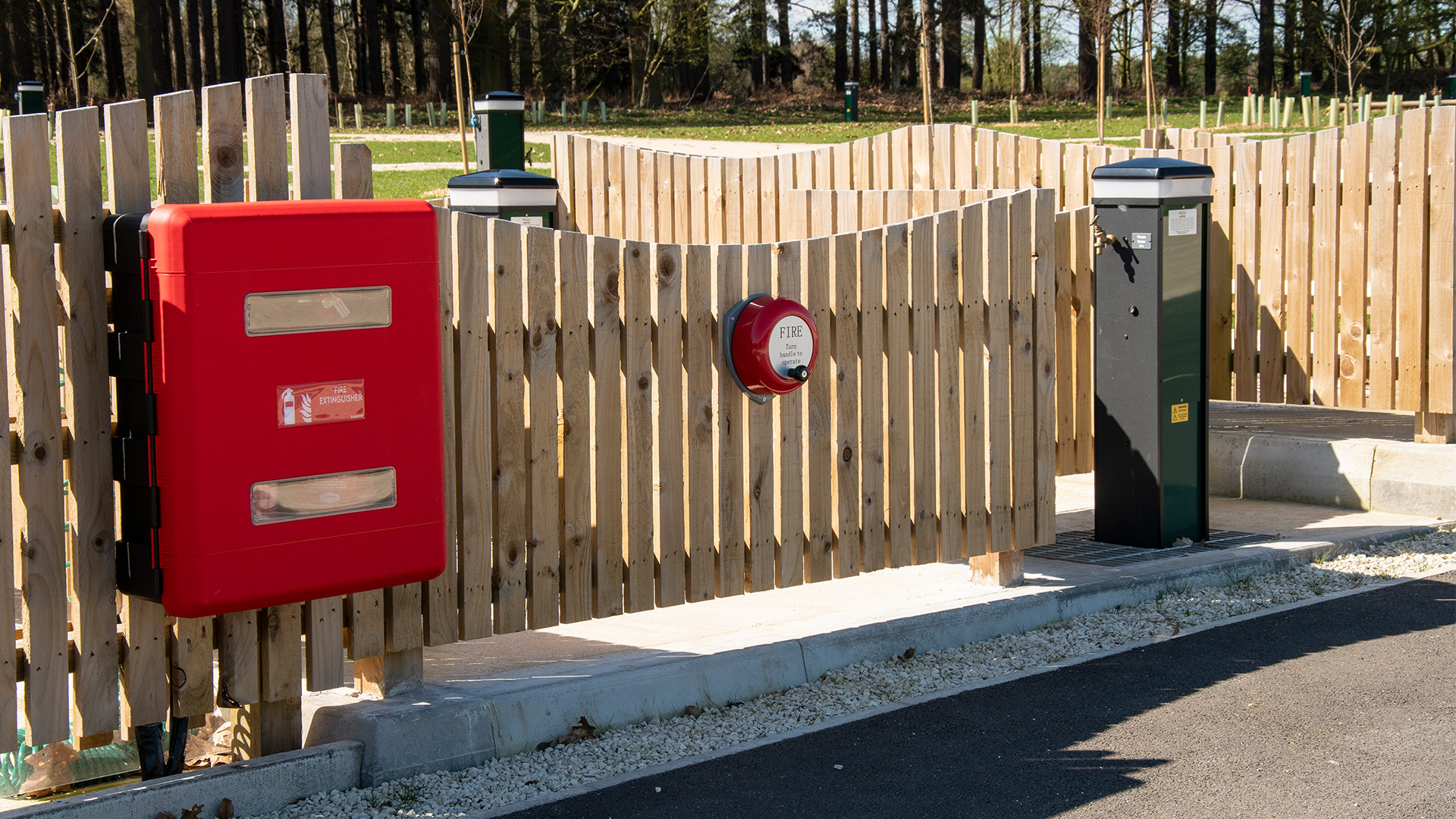
It’s very rare to have an accident or safety-related incident on a campsite and we’d like to keep it that way. Here are some pointers to help keep you and your family safe while you’re on site.
Carbon monoxide (CO) can kill
Carbon monoxide (CO) is produced when a fuel such as charcoal, gas or petrol burns incompletely. This could be because an appliance isn’t working properly or might simply happen as part of its normal function. Barbecues, for example, produce carbon monoxide even when they are working well.
Carbon monoxide is a colourless, odourless gas and is poisonous. In high concentrations it can kill swiftly. In smaller concentrations CO poisoning can give symptoms similar to flu or food poisoning. Look out for headaches, nausea and vomiting, dizziness, drowsiness and weakness - but the best advice is to avoid any chance of being poisoned in the first place.
Carbon monoxide safety tips
- Never take a barbecue into a tent, awning, caravan or motorhome. Even a cooling barbecue gives off plenty of poisonous carbon monoxide (CO), which can kill.
- Never use a fuel-burning appliance to heat your tent or awning. Gas and kerosene heaters – unless they are permanently fitted in a caravan or motorhome – it should only be used outside. Stoves and barbecues are designed for cooking not space heating.
- Never run a gas, petrol or diesel-powered generator or heater that is not designed for this purpose inside a caravan, motorhome, tent or awning. Make sure fumes from a generator don’t blow into your unit or anyone else’s from outside either.
- Don’t cook inside your tent or awning
- Don’t use any other gas, charcoal, liquid or solid fuel appliances inside a tent or awning. Gas-powered fridges and lamps, for example, also need plenty of ventilation to prevent them producing poisonous carbon monoxide. Tents and awnings aren’t generally designed with this in mind.
- Consider using a carbon monoxide (CO) alarm that is tested to BS EN50291-2 and Kitemarked, though it should never be used as an alternative to the precautions above.
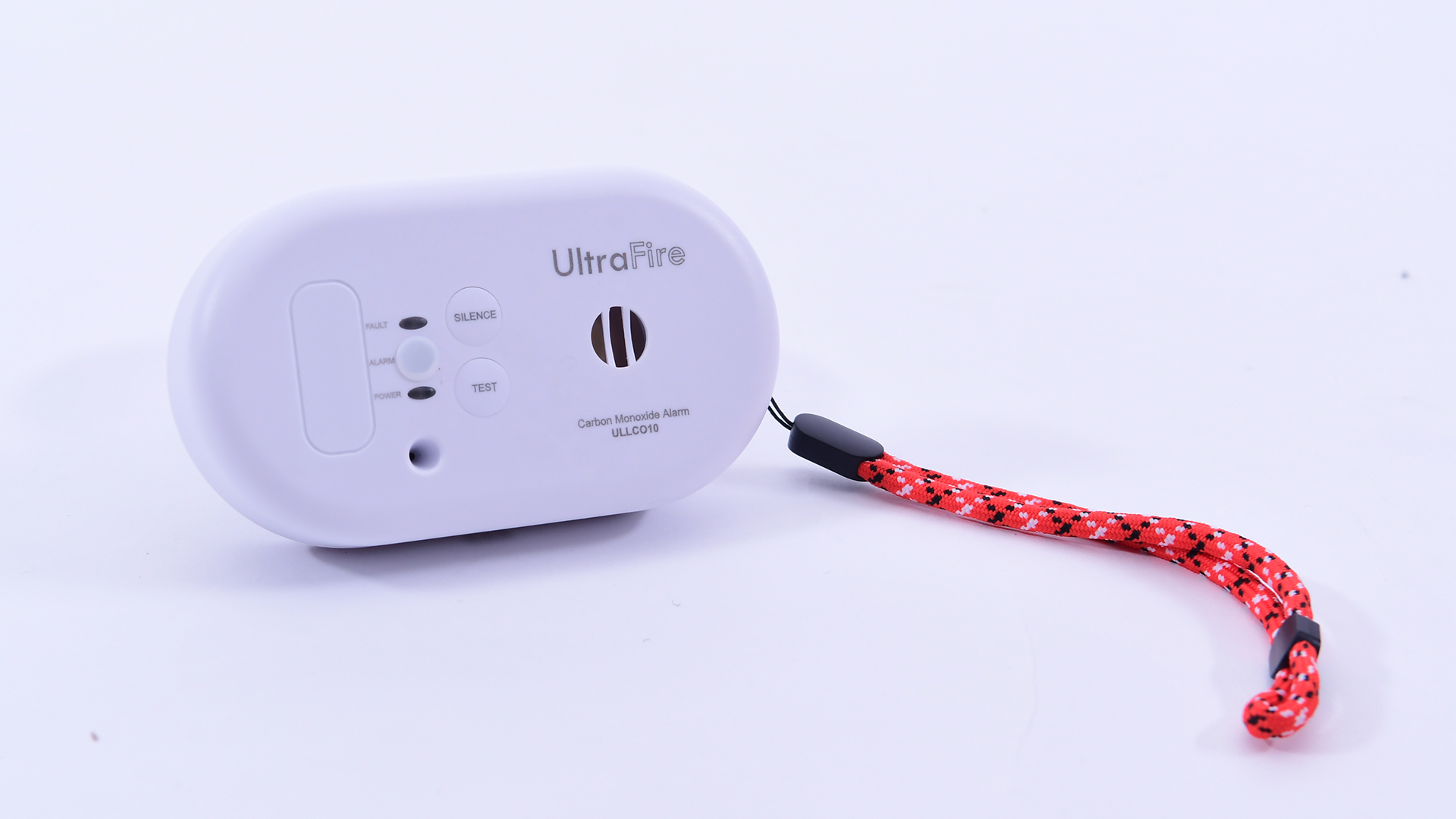
- CO alarms can be used in tents and awnings with the addition of a lanyard.
- Always have gas appliances in your caravan or motorhome serviced regularly. See our Expert Guide on servicing.
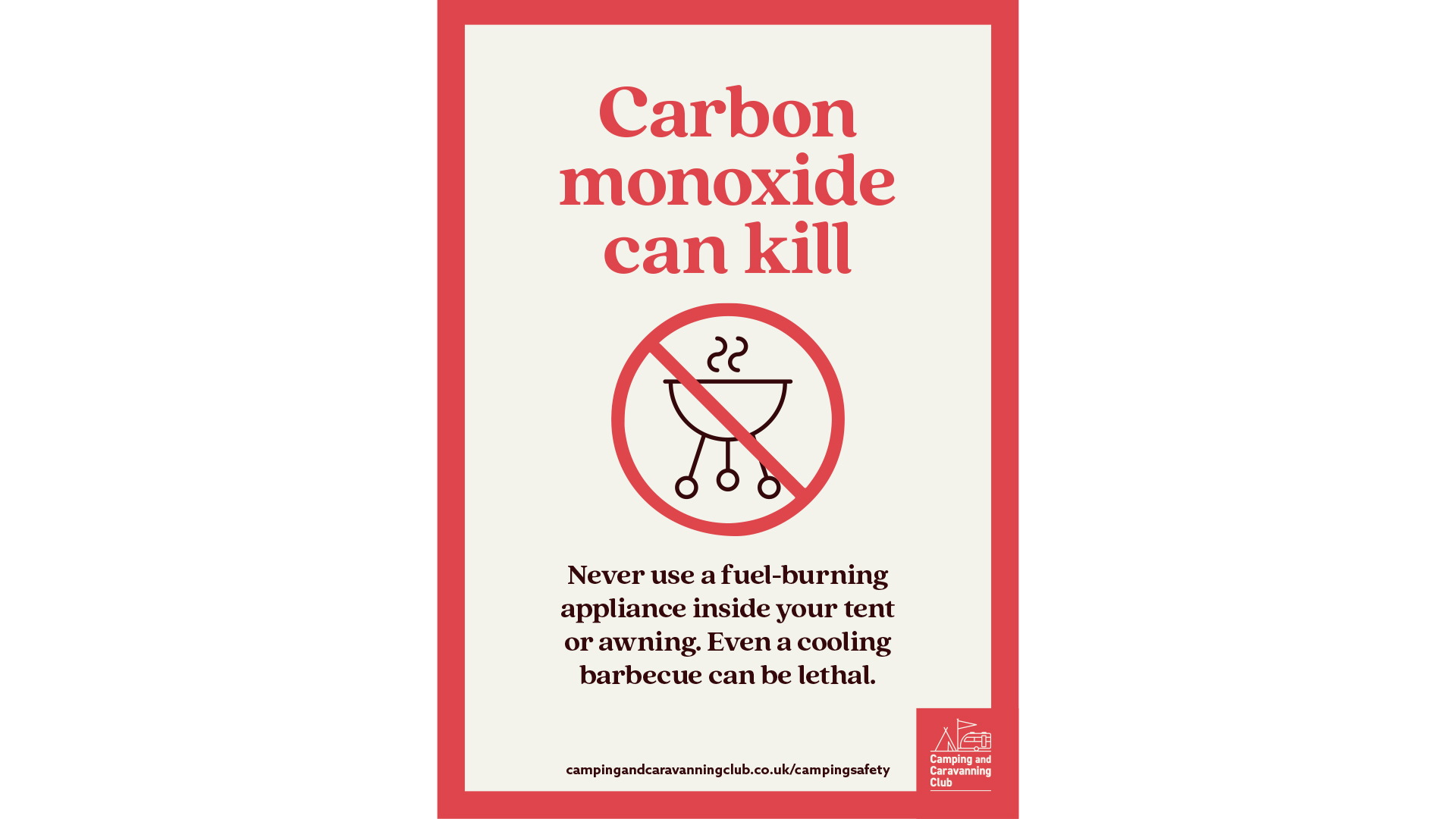
Spotting the danger signs of CO poisoning
You cannot smell, taste or see carbon monoxide but it can kill quickly and without warning. Early stages of carbon monoxide poisoning can give symptoms similar to food poisoning or flu, though without a high temperature.
- Symptoms to look out for include: Headaches; dizziness; feeling sick; tiredness and confusion; stomach pains or shortness of breath
- Higher concentrations can give more severe symptoms: Symptoms of intoxication; vertigo, as if the environment is spinning; loss of coordination; breathlessness and high heart beat rate; seizures or unconsciousness leading to death
There is more information on the NHS website. You can also download a leaflet about the dangers of carbon monoxide and a warning poster below.
Fire Safety
At most campsites – including all Camping and Caravanning Club Sites – tents, caravans and motorhomes are pitched at least 6m apart to prevent the spread of fire.
Make sure all in your group are aware what to do in case of a fire and where the emergency exits are, this is often a window if the main entrance is blocked. The universal fire safety advice is get out and stay out, use your fire fighting equipment to aid that evacuation.
The Club recommends you have a fire bucket full of water outside your unit, especially on campsites where no fire-fighting equipment is supplied.

When using a stove or BBQ raise it off the ground to avoid dry grass catching alight or damaging the pitch, you will usually find bricks for this purpose at the campsite water and fire points around the campsite. Avoid low overhanging flora above your BBQ too.

Consider adding an approved water mist fire extinguisher in your camping unit so its to hand. These can be used on most fires expected in leisure vehicles including electrical.

The Club does not recommend dry powder as there are a number of issues using these in an enclosed space such as compaction of the powder while travelling and severely reducing visibility in use. Dry powder can also cause breathing issues.
A fire blanket is also worth adding near the stove to smother any small fire quickly.
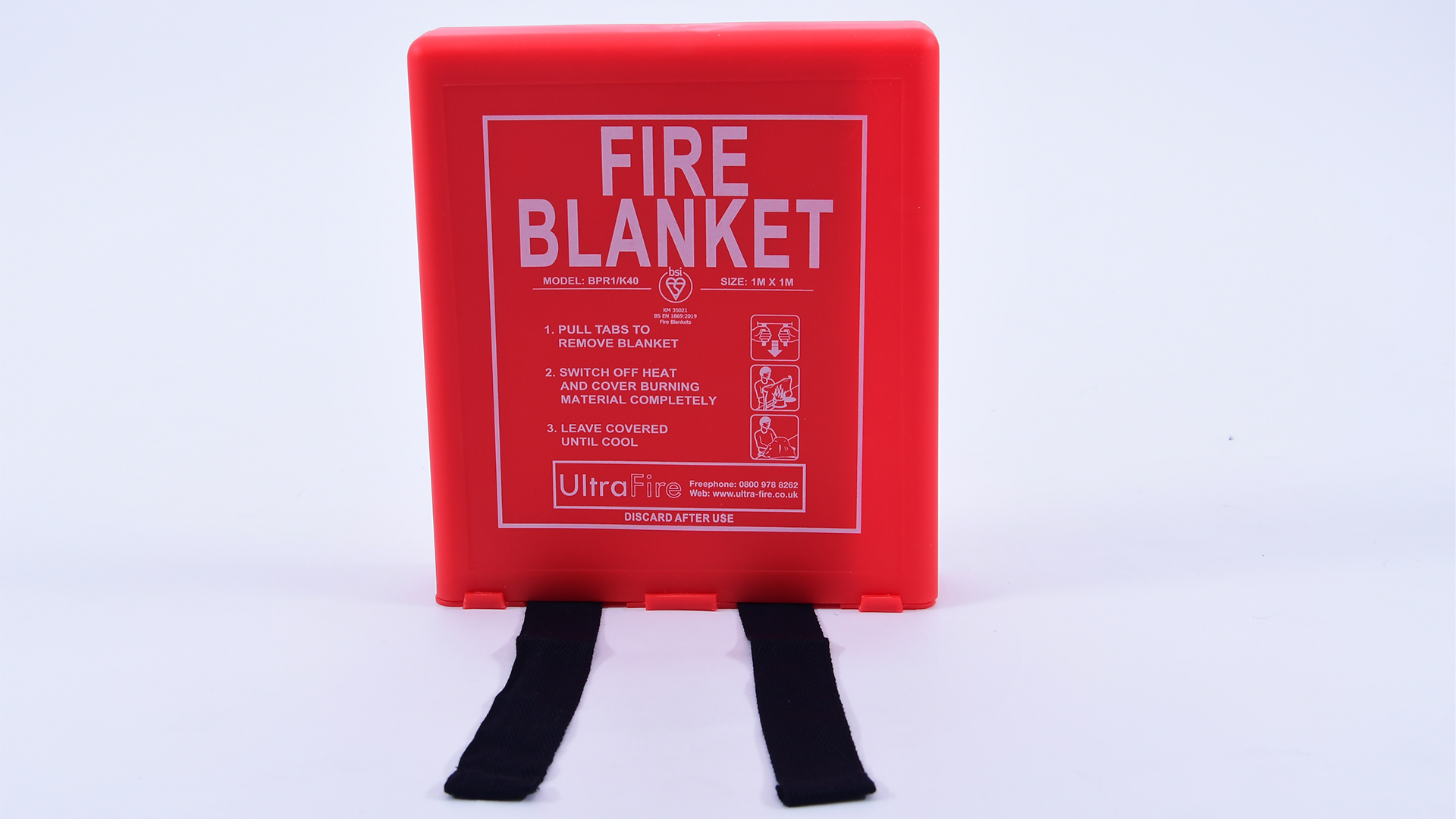
If connected to an external gas outlet, make sure the gas hose is not a trip hazard, but the appliance is far enough away to not cause a fire risk.
As always – the best advice is to avoid fire in the first place. There’s further good advice on the DirectGov website.
Smoke alarms
Don't forget to add a smoke alarm approved to BS EN14604, this can give you vital seconds to evacuate your unit. These are different to a carbon monoxide alarm as it detects detects the smoke of a fire. We recommend the optical type which are less likely to have false alarms in a small place like a tent, caravan, motorhome or campervan.

Looking after gas and other fuels
The reason we take gas, petrol or other liquid fuel on a campsite is to burn it for cooking, heating or lighting so it makes sense to look after it carefully at other times, so it doesn’t burn at the wrong time in the wrong place.
Always follow the supplier’s instructions on storage and transportation of fuel. Containers should be of an approved type. Fuel containers should be transported and stored upright and positioned carefully, so they cannot accidentally become disconnected or fall over and are less likely to leak.
When you are using any gas or liquid fuel appliances, it’s vital to have adequate ventilation. Don’t forget – many caravans and motorhomes will have a gas fridge working all the time. Poor ventilation and badly adjusted appliances can lead to a build up of poisonous carbon monoxide. If you have a caravan or motorhome you may have a carbon monoxide monitor fitted, but this should never be a replacement for having your appliances and gas installation serviced regularly.
Most tents or awning are often not designed with cooking in mind so make sure the cooking area is well away from the main accommodation. The same goes for the use of candles and smoking.
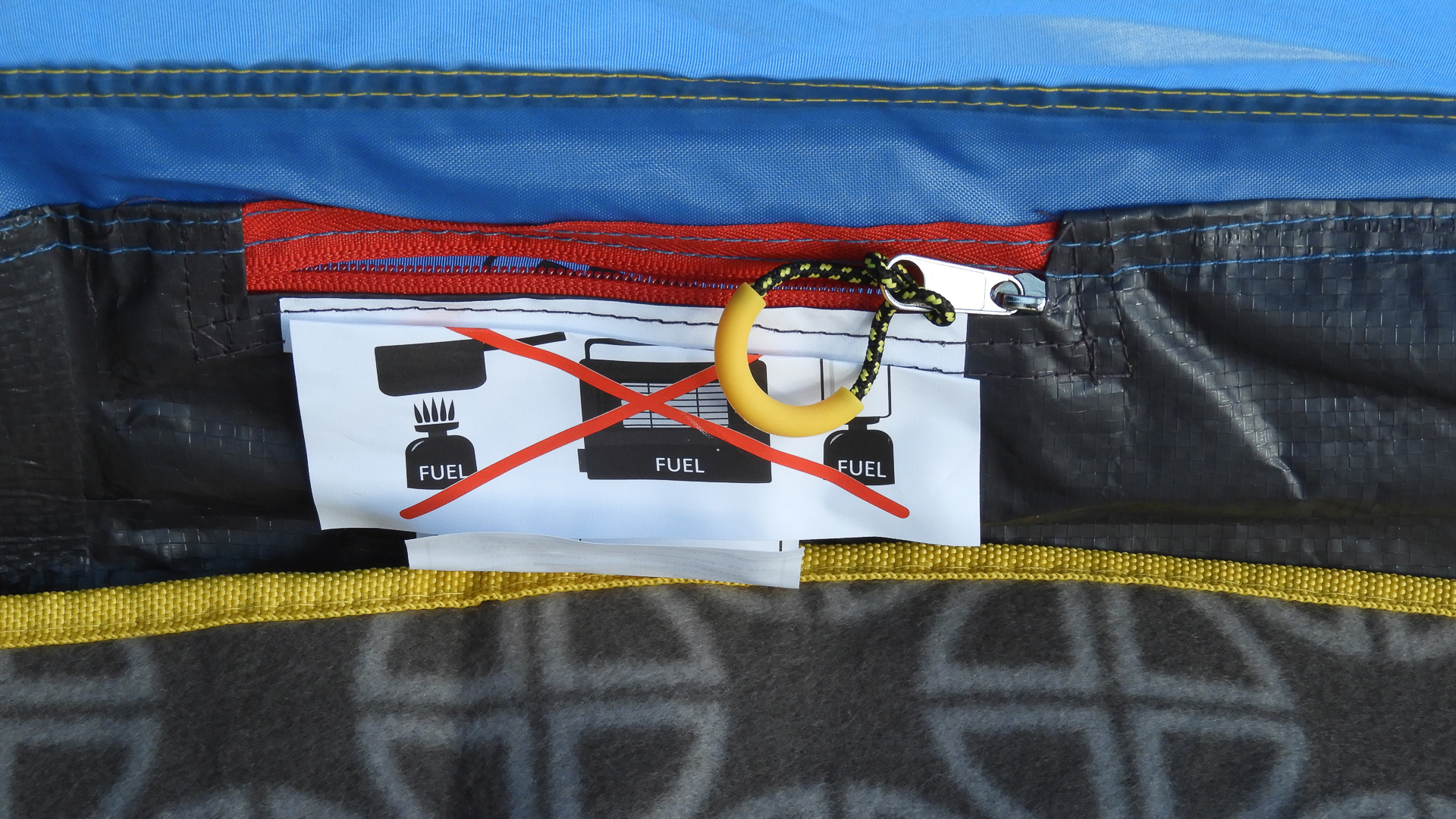
There’s more information about gas, its use and safe handling in our Gas for Caravans and Motorhomes and Gas for Tent Campers guides. The Club also has guidelines on the use of larger cylinders on site.
Electricity on site
There are several ways to use electrical appliances in your unit, from wind-up torches powered by your own hands through to mains-powered microwave ovens.
Used incorrectly electricity can be dangerous, especially in the damp environment you often find on a campsite.
Use the right kit
Always use a purpose-built lead designed for your type of unit. These have special weatherproof plugs and sockets designed to connect to the site’s hook-up point and your unit. If you have a caravan or motorhome, plug the lead into your unit first – then into the site bollard. This way you will not be carrying a live lead around.
We recommend using a 25m electrical hook-up (EHU) cable to avoid additional joints. Make sure you fully unroll your electric cable especially if you intend to use high wattage devices like heaters, this will allow any heat build-up in the cable to dissipate to the air safely.
If you would like to use mains electricity in your tent, check out the Club’s Expert Guide Using Electricity in your Tent on the subject. It’s especially important to keep all your electrical equipment dry. Make sure everything is kept off the ground and away from the tent fabric, where condensation can form.
Residual Current Devices (RCDs)
Wired into the circuit between your appliances and the site’s hook-up point will be a safety device known as a Residual Current Device (RCD).
An RCD is designed to cut off the supply immediately in the case of a leakage of current to earth. Such a leakage could occur if an appliance is faulty or in damp conditions. Do test them every time you plug into the electricity bollard.
How much power
Another thing you’ll need to think about is just what equipment you can plug in. At home you’ll probably have plenty of sockets and it’s rare to overload them, but a campsite supply is.
Try to use electrical equipment specifically designed for campers unless you know your kit is low powered. Don’t try to run your heater and kettle together – you’re likely to overload your pitch socket causing it to cut out and you may even cut out other sockets on the campsite.
It's worth noting the Club does not permit the use of EHU splitters connected to the campsite electrical bollard, instead take any additional power from sockets in your camping unit as this has the required circuit protection.
The same applies to electric and hybrid vehicles wishing to top up their batteries, they must not be plugged into the campsite bollard directly as this can overload the campsite electrics and may cause a fire.
You can find out more on the Club’s Electricity for Campers and Caravanners Expert Guide for specific advice.
Faulty leisure batteries
A faulty leisure battery or the mains charger it is connected to can cause the electrolyte within a lead acid battery to boil and produce an explosive gas that can easily be ignited. If a battery is too hot to touch there is something wrong - switch off the power supply and seek professional advice.

The Club recommends regular servicing of the habitation part of your leisure vehicle which includes testing the charger and battery.
Campsite hazards
Most of us will trip over a guy line or tent peg at least once during a camping trip, but it’s worth reminding everyone to look out for them – especially when returning to a tent or awning in the dark. There are glow in the dark guy lines available or you could put small solar lights close to the peg so you can see them. And please don’t try to push tent or awning pegs into the ground using your foot – too many puncture wounds are caused this way.
Make sure everyone is aware of the dangers of cars, caravans and motorhomes moving around the site and keeps well clear of them. Reversing caravans and motorhomes can provide particular hazards since the driver’s view is likely to be limited. Ideally, have someone outside your unit when you are reversing for safety. Our campsites have a speed limit of 5mph and often a one way system to help reduce the risks.
On a smaller scale, be extra careful when you are using portable steps to get into your trailer tent, caravan or motorhome. These can easily slip so it’s best to secure them to the ground if you can.
Many campsites are beautifully situated by lakes, rivers or streams but water can be dangerous if you don’t take proper care. Young children are especially vulnerable as they can drown in less than 2in (5cm) of water.
If there are electrical power cables overhead, be extra cautious with tent poles, fishing rods and kites. For more information on overhead power line safety see the Energy Networks safety advice here.
After the animals
If you camp in farmer’s fields you’ll sometimes find evidence of animals that have been there before you. Cattle, sheep and other animal droppings should be avoided because they can carry infections such as E.coli, salmonella and other nasties.
Children in particular can find animal droppings fascinating, so if you do find yourself in this situation, encourage children to wash their hands frequently. Make sure you wash your hands frequently, especially before preparing food or even pouring drinks. An anti-bacterial hand gel is a good first line of defence against these kinds of infections.
Living outdoors
A holiday on a campsite is just the same as any other holiday when it comes to sun exposure, protection against biting insects and the like - except you could spend longer outside so you may need to take extra care. Remember to use appropriate sun protection products and clothing. The SunSmart website has some useful information to help.
If you are planning on a solo camping trip let family and friends know where you are going and when you are expected to return, this is especially important if you intend to go off the beaten track. Make sure you have some basic kit like a compass, paper map, torch and whistle with you. Don't leave the safety of a campsite without clean water and a few high energy snacks. Make sure you have clothes that are appropriate to the location and conditions as the weather can change quickly.
In the UK most insect bites or stings are annoying but not dangerous – unless you suffer from an extreme reaction or the puncture site gets infected. You may like to consider using one of the many sprays, lotions or creams on the market that aim to prevent insects biting you in the first place.
Ticks
Ticks are often found in wooded areas and long grass and jump onto their host to feed. They can be avoided by wearing long socks and trousers. If a tick is found use specialised removal tools as shown below to extract them safely. The tick may be infected with Lyme Disease so monitor people or pets for the symptoms such as a bullseye rash at the puncture site in review the NHS advice on Lyme Disease.

Midgets or gnats
Midges can be found throughout the UK and are annoying at best, they are most active at dawn and dusk in calm conditions between May and September. If you are camping near still water or damp areas particularly in the Scottish Highlands consider covering your bare skin with light coloured clothing and wear a head net to avoid being bitten.
Processionary caterpillar
You might see processionary caterpillars, especially around oak or pine trees mainly in Southern Europe but they can be seen in the South East of England. Contact can cause serious irritation and can prove fatal to pets. If you see caterpillars on site, report it to campsite reception immediately.

Stink bugs
In recent years the Department for Environment, Food and Rural Affairs (Defra) have been monitoring the migration of brown marmorated stink bug (BMSB) into the UK. An increasing numbers of the pest are being found in and around caravans and motorhomes that seem to be hitch-hiking to the UK from Europe. For the first time in 2024, DEFRA have also found evidence that the pest has bred in this country. The pest is a potential problem for two reasons, damage to crops and they breed rapidly in domestic situations, causing a pungent odour.
The adult is between 12-17mm so it's worth checking you have no large gaps or vents that are not protected in your leisure vehicle. Even if you haven't been aboard and store in a compound or park close to other camping units check the wheel arches, external lockers and other sheltered areas regularly as the bugs gather together during autumn and winter.
DEFRA are asking caravan, motorhome and campervan owners to be on the look out for this stink bug and report findings to them on their vehicles. See the poster for more details of how to identify this type of pest and how to report it.

First aid
Always have a first aid kit to deal with simple emergencies. Don’t keep it sealed up until it’s needed. Check what is inside, make sure the contents are in date and you know how to use them.. Read the leaflet before an emergency occurs. That way you’ll be prepared.

The most important thing to remember is that first aid is precisely that – initial help for small cuts and bruises. If you are in any doubt at all about treating the patient or if you think there may be something seriously wrong then get proper medical attention.
Getting yourself trained in first aid might be a good idea. The British Red Cross, St John’s Ambulance and the St Andrew’s Ambulance Association in Scotland all organise local courses.
Pets
The Club welcomes all pets, please be respectful to other campers who may be less keen on our furry friends. Keep all pets on a two metre or less lead and in control when outside, make sure you clean-up any mess after them. When in long grass and wooded areas its possible your pet may pick up a tick on the skin, see Ticks above for our advice.
Seasonal Canine Illness
Seasonal Canine Illness may affect dogs during the autumn months. This illness is somewhat of a mystery as no specific cause has ever been identified. However, experts say that it affects dogs who have been walked in woodland areas specifically, so we recommend keeping your dog on a lead in these circumstances.
The severity of the illness varies and, in some cases, has been fatal, although the number of canine deaths has declined dramatically over the last few years. It is essential that you can recognise symptoms, including sickness, diarrhoea, and lethargy typically experienced within 72 hours of walking in woodland and seek veterinary help immediately if you do feel your dog could have contracted the illness. To read more on the topic and understand what to look out for, please visit the Blue Cross website.
Camping outside the UK
Most people would expect campsites to be the same from a safety aspect and many in mainland Europe are, but you should be careful as standards can vary. In the UK on Club Sites we maintain a 6m fire break. This is often not the case outside the UK so do consider contingency plans for escape, and additional fire fighting equipments like a fire bucket.
When it comes to electrical connections there can be quite a variation. You may not find the European standard blue connector sockets so having a safe solution is essential. Also the amperage supplied in often much lower than the 16A you find on most UK campsites, so consider the demands you are placing on the campsites infrastructure to avoid overloading.

Refer to our Expert Guide to Touring Mainland Europe for more advice
It's worth noting pests like processionary caterpillars and stink bugs are more common in Mainland Europe, see our advice in Living Outdoors above.
Further information from the club
See more carbon monoxide safety advice below.
Watch our Playmobile CO safety video here:

